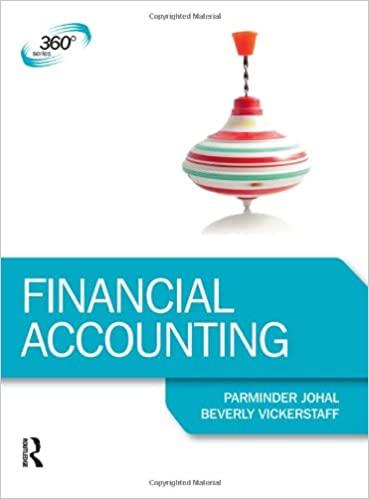Question
The following transactions were completed by Winklevoss Inc., whose fiscal year is the calendar year: Year 1 July 1. Issued $5,840,000 of five-year, 10% callable
The following transactions were completed by Winklevoss Inc., whose fiscal year is the calendar year:
| Year 1 | |
| July 1. | Issued $5,840,000 of five-year, 10% callable bonds dated July 1, Year 1, at a market (effective) rate of 11%, receiving cash of $5,619,902. Interest is payable semiannually on December 31 and June 30. |
| Oct. 1. | Borrowed $290,000 by issuing a 10-year, 7% installment note to Nicks Bank. The note requires annual payments of $41,289, with the first payment occurring on September 30, Year 2. |
| Dec. 31. | Accrued $5,075 of interest on the installment note. The interest is payable on the date of the next installment note payment. |
| 31. | Paid the semiannual interest on the bonds. The bond discount amortization of $22,010 is combined with the semiannual interest payment. |
| Year 2 | |
| June 30. | Paid the semiannual interest on the bonds. The bond discount amortization of $22,010 is combined with the semiannual interest payment. |
| Sept. 30. | Paid the annual payment on the note, which consisted of interest of $20,300 and principal of $20,989. |
| Dec. 31. | Accrued $4,708 of interest on the installment note. The interest is payable on the date of the next installment note payment. |
| 31. | Paid the semiannual interest on the bonds. The bond discount amortization of $22,010 is combined with the semiannual interest payment. |
| Year 3 | |
| June 30. | Recorded the redemption of the bonds, which were called at 98. The balance in the bond discount account is $132,058 after payment of interest and amortization of discount have been recorded. Record the redemption only. |
| Sept. 30. | Paid the second annual payment on the note, which consisted of interest of $18,831 and principal of $22,458. |
Required:
Round all amounts to the nearest dollar.
1. Journalize the entries to record the foregoing transactions. If an amount box does not require an entry, leave it blank.
| Date | Account | Debit | Credit |
|---|---|---|---|
| Year 1 | |||
| July 1 | Bonds PayableCashGain on Bonds PayableInterest ExpenseInterest Payable | ||
| Bonds PayableDiscount on Bonds PayableInterest ExpenseLoss on Bonds PayablePremium on Bonds Payable | |||
| Bonds PayableCashDiscount on Bonds PayableInterest ExpensePremium on Bonds Payable | |||
| Oct. 1 | Bonds PayableCashInterest ExpenseInterest PayableNotes Payable | ||
| Bonds PayableCashInterest ExpenseInterest PayableNotes Payable | |||
| Dec. 31-Note | Bonds PayableCashInterest ExpenseInterest PayableNotes Payable | ||
| Bonds PayableCashInterest ExpenseInterest PayableNotes Payable | |||
| Dec. 31-Bond | Bonds PayableCashInterest ExpenseInterest PayableNotes Payable | ||
| Accounts PayableBonds PayableDiscount on Bonds PayableInterest ExpenseInterest Payable | |||
| Bonds PayableCashInterest ExpenseInterest PayableNotes Payable | |||
| Year 2 | |||
| June 30 | CashDiscount on Bonds PayableInterest ExpenseInterest PayableNotes Payable | ||
| Accounts PayableBonds PayableDiscount on Bonds PayableInterest ExpenseInterest Payable | |||
| Bonds PayableCashInterest ExpenseInterest PayableInterest revenue | |||
| Sept. 30 | Accounts PayableBonds PayableCashDiscount on Bonds PayableInterest Expense | ||
| Accounts PayableBonds PayableCashInterest PayableLoss on Bonds Payable | |||
| Bonds PayableCashDiscount on Bonds PayableGain on Bonds PayableNotes Payable | |||
| Bonds PayableCashInterest ExpenseInterest PayableNotes Payable | |||
| Dec. 31-Note | CashDiscount on Bonds PayableInterest ExpenseInterest PayableNotes Payable | ||
| CashDiscount on Bonds PayableInterest ExpenseInterest PayableNotes Payable | |||
| Dec. 31-Bond | Discount on Bonds PayableInterest ExpenseInterest PayableLoss on Bonds PayableNotes Payable | ||
| Accounts PayableBonds PayableDiscount on Bonds PayableInterest ExpenseInterest Payable | |||
| Bonds PayableCashGain on Bonds PayableInterest ExpenseInterest Payable | |||
| Year 3 | |||
| June 30 | Bonds PayableCashGain on Redemption of BondsInterest ExpenseNotes Payable | ||
| CashDiscount on Bonds PayableInterest ExpenseLoss on Redemption of BondsNotes Payable | |||
| Bonds PayableDiscount on Bonds PayableGain on Redemption of BondsInterest ExpenseInterest Revenue | |||
| Bonds PayableCashGain on Redemption of BondsInterest ExpenseNotes Payable | |||
| Sept. 30 | Accounts PayableBonds PayableCashGain on Bonds PayableInterest Expense | ||
| Bonds PayableCashDiscount on Bonds PayableInterest PayableLoss on Bonds Payable | |||
| Bonds PayableCashDiscount on Bonds PayableLoss on Redemption of BondsNotes Payable | |||
| CashDiscount on Bonds PayableInterest ExpenseInterest PayableNotes Payable |
2. Indicate the amount of the interest expense in (a) Year 1 and (b) Year 2.
a. Year 1 b. Year 2
3. Determine the carrying amount of the bonds as of December 31, Year 2.
Step by Step Solution
There are 3 Steps involved in it
Step: 1

Get Instant Access to Expert-Tailored Solutions
See step-by-step solutions with expert insights and AI powered tools for academic success
Step: 2

Step: 3

Ace Your Homework with AI
Get the answers you need in no time with our AI-driven, step-by-step assistance
Get Started


